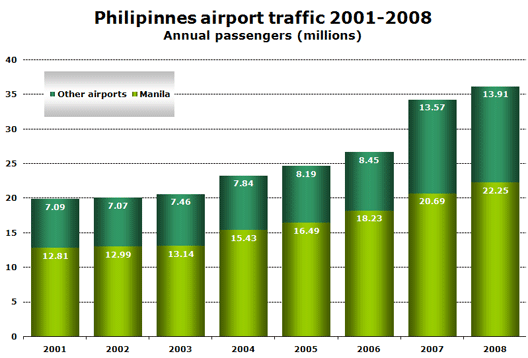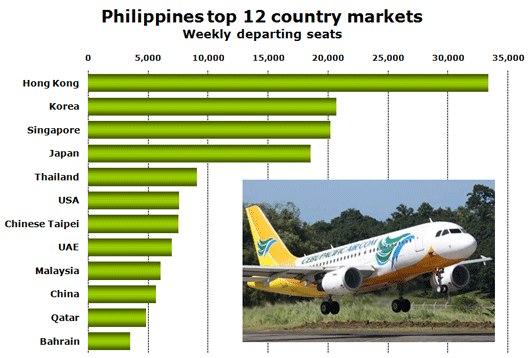
As Cebu Pacific and Philippine Airlines vie for domestic dominance
July 25, 2009
 |
| At Ninoy Aquino International Airport (the main international gateway to the Philippines) lucky passenger Grace Geloca - (green t-shirt) looks bewildered as she claims the impressive prize from James Go, JG Summit Holdings’ CEO (owners of Cebu Pacific), Gloria Macapagal-Arroyo, (President) and Lance Gokongwei, Cebu Pacific’s CEO. |
The Philippines consists of over 7,000 separate islands in the western Pacific Ocean and with an estimated population of over 90 million, air travel is playing a critical part in the country’s rapid economic development. According to OAG data there are currently 38 airports offering scheduled services. Of these just six offer international flights and three of them have just two weekly international services. This leaves Ninoy Aquino International Airport in Manila (MNL), Mactan-Cebu (CEB) and Diosdado Macapagal (CRK) as the only real international gateways. Diosdado Macapagal is also known as Clark, a reflection of its former life as Clark Air Force Base before the eruption of Mount Pinatubo in 1991.
 |
| Source: CAAP |
Traffic growth has been impressive in recent years though the 2006 figure for ‘Other’ airports would appear to be an underestimate as Cebu’s traffic data appears to be missing for much of the year. In 2007 Mactan-Cebu handled just over four million annual passengers while Clark processed just over half a million passengers.
Cebu Pacific and PAL dominate domestic markets
Domestic air travel is dominated by two major airlines, Cebu Pacific and Philippine Airlines. Between them they account for over 85% of the scheduled domestic capacity.
| Airline | Frequency share | Capacity share | Domestic routes |
| Cebu Pacific | 44.6% | 47.3% | 50 |
| Philippine Airlines | 34.0% | 38.3% | 37 |
| Zest Air | 11.7% | 9.2% | 18 |
| Air Philippines | 4.1% | 3.9% | 7 |
| Seair | 5.5% | 1.1% | 7 |
| Source: OAG Max Online for w/c 6 July 2009 | |||
Cebu Pacific's position is impressive given that it only started operations after local deregulation in 1996. It now operates a fleet of some 30 aircraft, a mix of A319/A320s and ATR 72-500s. Zest Air (formerly known as Asian Spirit) will soon be launching several new routes from Cebu to further increase its market share.
The busiest domestic airports after Manila and Cebu are Davao (DVO), Iloilo (ILO), Caticlan (MPH) and Cagayan de Oro (CGY). Both Davao (1.7 million) and Iloilo (1.1 million) handled more than one million passengers in 2008.
 |
| Cebu Pacific moved all its domestic and international services into Manila’s (once unused) Terminal 3 last year. The fleet comprises 21 A319 and A320s and 8 ATR 72-500s - all fly to 32 domestic and 14 international destinations. |
Hong Kong leading international market
A total of 23 countries can be reached non-stop from airports in the Philippines. The leading country market is Hong Kong with 130 weekly departures. Cathay Pacific, Cebu Pacific and Philippine Airlines all offer at least four daily flights from Manila, while Cebu Pacific also operates daily from Cebu and Clark.
 |
| Source: CAAP |
Non-stop flights to the US are provided by Philippine Airlines to Honolulu, Los Angeles and San Francisco, while the airline also serves Vancouver. The MEB3 (Middle East Big Three) airlines are all present and correct with at least daily departures to Abu Dhabi, Doha and Dubai, while Gulf Air and Saudi Arabian also serve Manila from their home bases.
The only non-stop service to Europe is currently provided by KLM which operates daily flights to Amsterdam.
http://www.pbase.com/philippineaviation/image/95782073 is the origin of the Cebu Pacific take-off image on the 'Hong Kong leading int'l market' chart.
ReplyDelete